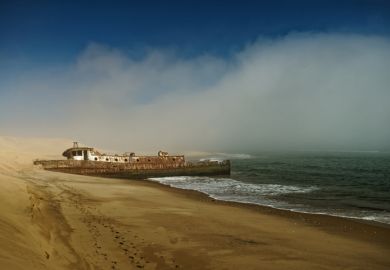Not so long ago, the economy was widely assumed to hold the key to understanding the Third Reich. It was fashionable to see German fascism as a consequence of capitalism and to repeat the mantra of Max Horkheimer that "whoever does not want to speak about capitalism should remain silent about fascism".
But the focus shifted. Today it is the mass-murder campaigns of the Nazis, not their relationship with big business, that frame attempts to understand the history of the Third Reich. Not economics but ideology, not profit but violence, not business but racism have come to be regarded as the forces that drove Nazism. Over the past 20 years, the economic history of Nazi Germany has, Adam Tooze notes in the preface of his weighty new book, "progressed very little".
Tooze aims to redress this, taking advantage of a mass of detailed research published over the past 20 years. But The Wages of Destruction is more than an economic history; it is a broad attempt to rewrite the history of the Third Reich and its Second World War.
Tooze takes issue with some older interpretations and shows that the Nazi regime gave priority to military expenditure from the outset: the rise in the share of military expenditure from 1 per cent in 1933 to 10 per cent in 1935 was a reallocation of national production on a scale that "had never been seen in any capitalist state in peacetime". (By 1938 it was 20 per cent and by the first year of the war it was more than one third.) Not surprisingly, Hitler's determination to press on with a gigantic armaments programme led to severe difficulties - inflationary pressures, foreign-exchange crises, shortages of labour and raw materials. But none of this caused the regime to step back, and there is little evidence that concern about domestic morale limited the Nazi war effort. Hitler wanted armaments, regardless of the immediate needs of the civilian population. The concern to win a short war was motivated not by fear of popular opinion but by fear of a protracted war in which Nazi Germany's enemies, with greater resources at their disposal, would win.
Central to understanding this, according to Tooze, is the role of the US. For Germany, the incredible growth of American economic power posed a critical question - whether to recover Germany's economic and political position after the First World War by working with the US, or to confront what was becoming the world's superpower. Hitler chose confrontation.
At the same time, the affluence that Americans had come to enjoy provided the model for Hitler's ambition "to make the German people rich and Germany beautiful" and to "see the living standard of the individual raised". Given the resources at Germany's disposal in the 1930s this appeared a vain hope, but that does not mean Hitler's professed aims were hot air. As Tooze asserts, there appeared a way to bring American standards of living to the Aryan: through "the newly assembled Wehrmacht, the instrument through which Germany would achieve American-style living space".
Ideological as well as economic considerations came into play. By the late 1930s, the Nazi leadership increasingly regarded America as "the fulcrum of a world Jewish conspiracy for the ruination of Germany and the rest of Europe". This, according to Tooze, helps explain why Germany went to war in 1939 despite the huge risks involved. Growing American hostility towards Germany, a hostility that Hitler saw as inspired by Jews, reinforced the desire to strike before the US could get involved decisively in the inevitable conflict.
What is more, American support for Britain contributed to Hitler's decision to invade the USSR. In Tooze's view, "Barbarossa" was not least "a means to the end of consolidating Germany's position for the ultimate confrontation with the Western powers". That campaign was - and Tooze is not the first person to see this - the first actually planned as a "Blitzkrieg"
(lightning war). However, that Blitzkrieg was not designed to spare the home front hardship but to ensure that resources (especially oil in the Caucasus and grain in Ukraine) would be available for the final showdown with Britain and the US.
Another central theme in this book is food. In a country that had suffered hunger in the recent past, it is hardly surprising that the Nazi leadership was unwilling to accept a division of the globe whereby much of the world's agricultural resources was in the hands of the British (via the Empire) and the Americans. The Nazi pursuit of "living space" may have been barbarous, but it was not without its logic.
Once the Agriculture Ministry had been taken over by Walther Darre and Herbert Backe, that logic became murderous. During the war it provided the basis for grandiose plans to starve to death 20 million to 30 million people in the conquered USSR, so that the resulting agricultural surplus from Ukraine might be used to feed Germans. Furthermore, callous concern about "useless eaters" in a Europe without sufficient food supplies helps to explain the campaign to murder the Continent's Jewish population.
Finally, Tooze completes the well-deserved demolition job on the reputation of one of the greatest criminals of the 20th century, Albert Speer. We now know that Speer was both aware of and, through his role in using slave labour, an active participant in Nazi crimes.
But Tooze also undermines "the myth of the so-called armaments miracle", which allegedly occurred after Speer had become Armaments Minister in 1942. The subsequent increases in armaments production owe much to preparations in place before Speer got the job. In Tooze's view, Speer's well-trumpeted successes - and the Armaments Minister certainly blew his own trumpet - also "shut down the train of reasoning that moved from a rational assessment of Germany's war capacity", namely, that Germany could not win the war and needed to find a "political" solution. No wonder Hitler was pleased with his architect. Speer, perhaps more than anyone else, was responsible for the fact that the war continued as long as it did.
In sum, this is a great book - one of the most important to be written about the Third Reich in years. While not all of his insights are quite as novel as he suggests, Tooze rightly places war at the centre of the history of Nazism, challenges many hitherto accepted views of Nazi policies, masterfully integrates the economic with the military history of the Third Reich, and gives us a fresh and persuasive narrative. We are in his debt.
Richard Bessel is professor of 20th-century history, York University.
The Wages of Destruction: The Making and Breaking of the Nazi Economy
Author - Adam Tooze
Publisher - Allen Lane, Penguin
Pages - 800
Price - £30.00
ISBN - 0 713 99566 1



